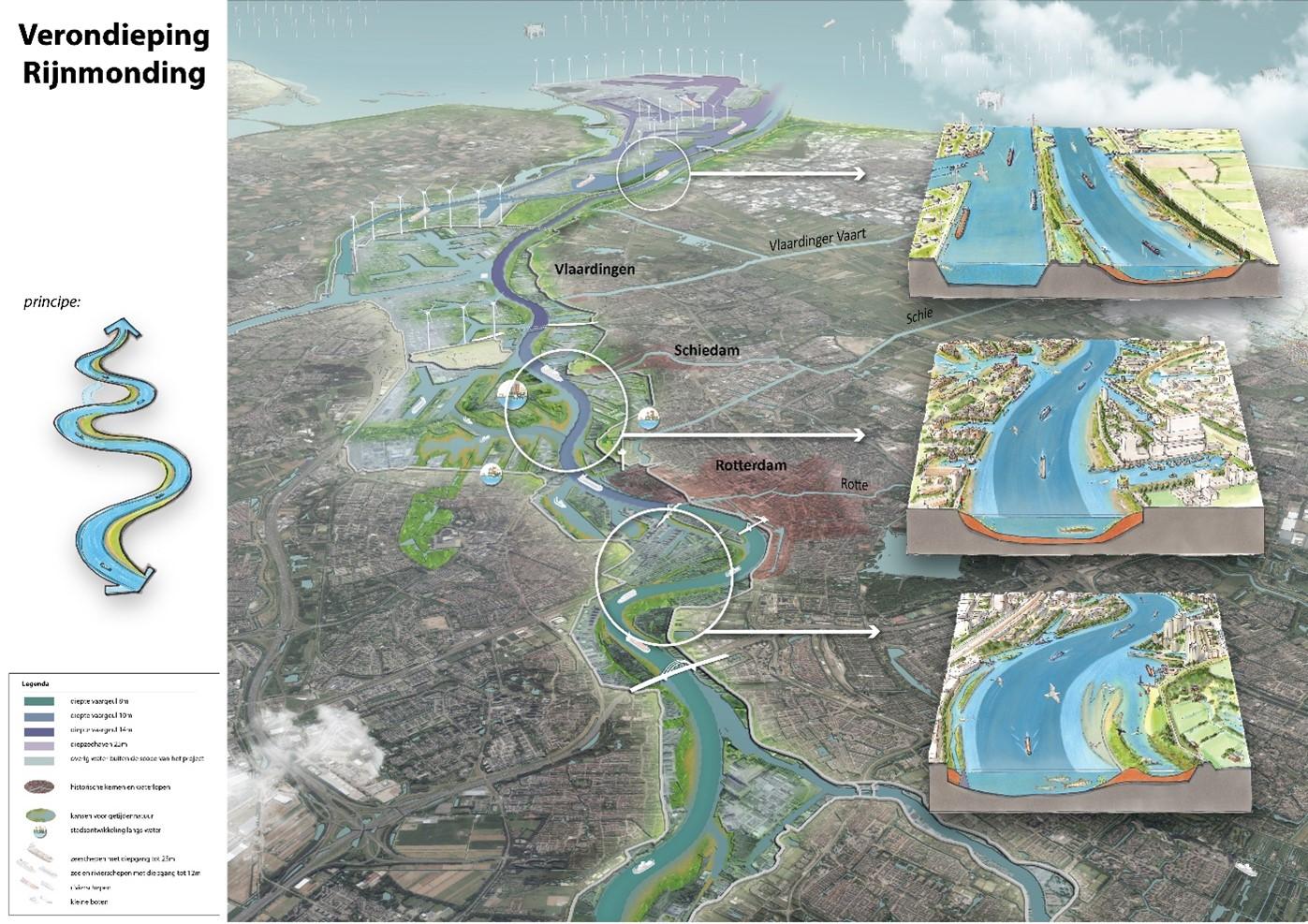Han Meyer
Next year, 2022, will be the 150th anniversary of the New Waterway. This artificial access from the sea to the port of Rotterdam was put in use in 1872 and led to explosive economic and urban developments in the Rotterdam region. In this Blue Paper, Han Meyer argues that after these 150 years, it is time to fundamentally reconsider policies regarding the New Waterway. Instead of making the natural environment dependent from economic growth, economic development should become dependent on the possibilities delivered by a sustainable natural system. The project ‘The Rhine Mouth as an Estuary’, a co-operation by Meyer, ARK Natuurontwikkeling and the World Wildlife Fund, explores such a radical reversal for the New Waterway.
The project ‘The Rhine Mouth as an Estuary’ considers the future of the Rotterdam port region concerning the future of the Rhine-Meuse delta as a whole. This relationship needs a fundamental revision because of climate change, sea-level rise and the energy transition. The delta is a complex system, defined by the dynamics and mutual influences of natural systems, hydraulic engineering works, and economic and urban developments. Especially in the industrial age, since the mid-19th century, technical interventions driven by economic development have influenced and changed this complex system fundamentally. Nowadays, the whole system of rivers and delta can be considered a hydraulic machine, regulated by dikes, dams, locks and weirs. To accommodate ever larger container ships, the New Waterway is subject to continuous dredging.
It is, however, no longer the question how long this artificial system can be maintained, but whether it should be maintained. Facing these new challenges in combination with what Jeremy Rifkin (2011) calls the ‘Third industrial revolution’, we have to reconsider the whole Rhine-Meuse delta system and create new perspectives for a vital and sustainable balance of the natural environment, hydraulics and economic and urban development. Instead of submitting natural systems to maximum economic development, we should explore how space for natural development can create new opportunities and challenges for economic and urban development, and how this can be supported by smart hydraulic systems.
‘The Rhine mouth as an estuary’ is such a perspective for the Rhine-Meuse delta, with special attention to the region of Rotterdam and the New Waterway. The central statement of the project is that the estuary character of this river mouth should be repaired by stopping the process of continuous dredging. Allowing the process of sedimentation will result in a shallower river channel with more gradual transitions from land to water. This will create new opportunities for a restoration of the estuary character of the river mouth, with more natural wildlife and biodiversity. Additionally, this sedimentation process will result in more natural protection against high waters and salt intrusion. It will also create conditions for new spatial coherences and attractive urban patterns.

To stop the dredging, however, will indeed require a serious adaptation of the port and related industry. We argue that this adaptation is inevitable because of the urgency of the energy transition. Moreover, this new approach to the river mouth can function as an accelerator of the necessary processes of the energy transition and the building of a more circular and sustainable port economy. Instead of considering economic development as the leading force to which the natural environment should be adapted, we should reason the other way around: for the sake of mother earth, we should give absolute priority to a sustainable natural system, and adapt economic development to this system.
‘The Rhine mouth as an estuary’ combines different agendas of nature, water, economy, and the urban environment. It states that a ‘nature-based solution’ is necessary and possible, also for this artificial river mouth. From May 2021 onwards, H+N+S Landscape Architects will be involved in the project, to explore the possibilities of combining all different agendas. The project is based on a series of hypotheses concerning hydraulics, ecosystems, and new urban and industrial development. We like to challenge students and researchers, but also policy makers and designers, to explore these hypotheses and to contribute to the substantiation of this perspective.
Because many port city-regions are struggling with similar problems, the project is relevant to international debates on the future of port cities and delta regions. The national Delta Program, which is responsible for water safety in the Netherlands on the short and long term, has taken the project into consideration as one of the possible future scenarios for the Netherlands. With Rotterdam being the largest port of Europe and the Netherlands a frontrunner on water management, the New Waterway can, once again, be an inspiring example for deltas and estuaries worldwide.
Acknowledgement
The Blue Papers is a series of thought-provoking short essays on water. Authors have been invited by the platform Water Values: Connecting Past, Present & Future, an initiative of ICOMOS-NL, TU Delft and University of Groningen to argue the importance of heritage and a cultural approach within water related challenges.
The preliminary report of this project can be downloaded from https://www.ark.eu/nieuws/2021/minder-zout-en-meer-natuur-door-ondiepere-rijnmonding
References
Jeremy Rifkin (2011). The Third Industrial Revolution. How Lateral Power is Transforming Energy, the Economy, and the World.
